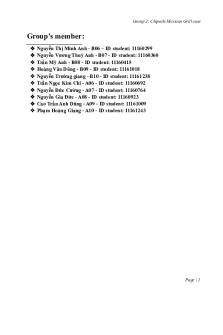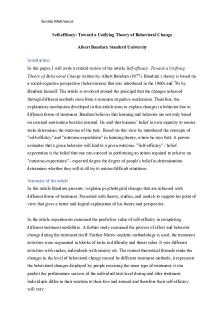MGT10001 - Assignment 3 - Individual Essay PDF

| Title | MGT10001 - Assignment 3 - Individual Essay |
|---|---|
| Course | Economic Principles |
| Institution | Swinburne University of Technology |
| Pages | 6 |
| File Size | 96.5 KB |
| File Type | |
| Total Downloads | 45 |
| Total Views | 154 |
Summary
Download MGT10001 - Assignment 3 - Individual Essay PDF
Description
MGT10001 INTRODUCTION TO MANAGEMENT
ASSIGNMENT 3 INDIVIDUAL ESSAY
DEBORA AGUILAR DE OLIVEIRA – 102932273
SWINBURNE UNIVERSITY ONLINE
DUE DATE: MONDAY 21 SEPTEMBER 2020
WORD COUNT: 1,480 WORDS
Management is one of the most well-known concepts nowadays, and yet one of the most difficult to be defined. According to Henri Fayol (2002, p. 7), ‘To manage is to forecast and to plan, to organize, to command, to co-ordinate and to control’. These five functions are essential for the success of any management strategy and help managers to concentrate their efforts on what is relevant. The combination of a solid business structure along with the correct management models and terrific managers is crucial for a business to achieve its goals. ‘How well managers manage and are managed determines whether business goals will be reached. It also largely determines how well the enterprise manages worker and work’ (Drucker 1995, p. 4). This essay presents 4 management techniques that could improve organizational performance within a business, being: Communication Process (Team Management), Decision-Making (Planning), Employee Motivation (Leadership), and Social Responsibility (Controlling). For the purpose of protecting the privacy of the chosen business mentioned on this essay, the company will be referred to as “Company X”. Company X is a hospitality business that has been in the market for nearly twenty years, it is mostly managed for its only Director and has around seventy employees spread out around five venues. The first method to be explored is the Communication Process, which can be condensed in four steps: sender, message, channel and interpreted meaning. Communication happens once all four components are clearly defined, however what seems to be a very straight-forward process can become extremely messy if people do not know what to do with them. It is often forgotten that listening is as important as speaking in the communication process, and since it is a skill rather than just the ability to hear, it needs to be developed to serve its targets. Successful management communication is indispensable for guiding teams and ensuring that the business operations are heading in the correct direction, and some of the most common errors are not being direct enough or honest enough; yelling, screaming or getting emotional; communicating in an inappropriate forum; and making it personal (Business Victoria, 2020). At Company X, communication is an ongoing problem that no one seem to be able to resolve. The Director believes that the problem is among the staff, including managers and supervisors, and the result is a very unstable team with high turnover rates. What the Director fails to realize is that his very controlling management style and poor communication skills are reflecting badly on the staff and affecting the whole team. In the many occasions where managers tried to improve the communication process, by being transparent and not getting emotional when dealing with staff, the Director did not appreciate the changes and instructed them to be dismissed. A workplace where everyone is afraid to speak up, gossip is encouraged and emotions are always interfering, unfortunately communication does not have room to be effective. In this scenario, these effective communication techniques could be helpful: be direct and honest and provide truthful feedback; be
specific and use examples; remember to praise in public and criticise in private; and focus on the facts (Business Victoria, 2020). The second concept to be examined is Decision-Making, which is a process composed by eight steps (Coulter 2017, p. 188). Step one is to identify the problem (the discrepancy between the desired situation and the real situation); step two is to identify the decision criteria (guidelines or requirements to make a decision); step three is to allocate weights (in case criteria identified on step two have different degrees of importance); step four is to develop alternatives (gather possible resolutions for the problem); step five is to identify the problem (analyse alternatives gathered on step four by appraising it against the criteria established in previous steps two and three); step six is to choose an alternative (select the best resolution to fix the issue); step seven is to implement the chosen alternative (ensure the decision is put into action); and step eight is to evaluate the decision made (check whether the issue has been resolved). While these eight steps are recommended, the Decision-Making process is very dynamic and must be adjusted according to the business structure and management strategy. Some businesses utilize all these steps, whilst others require fewer steps only. Managers are called decision-makers because deciding is an activity intrinsic to their position in the company, and making decisions is part of planning, organising, leading and controlling – the four managerial functions. In a leadership role, the ability to make effective decisions is essential to success, however the following common habits can lead to poor decision making results: making a misinformed decision; rushing the process; not forward thinking or planning; indecisiveness; and poor ability to convey the decision made (Australian Institute of Business, 2020). At Company X, the decision-making process is rather an emotional process than a rational one. The Director repeatedly decides based on personal feelings and impressions, but worse than that is the fact that more common is for him not to decide at all. Poor decision making, skipping necessary steps or simply a lack of decision making is a sign of lack of leadership (Corredor, 2020). It has devastating consequences on the team, leaving them confused and discouraged, with little motivation to work. A formal and coordinated decision-making process is deeply needed at Company X, and it would bring very positive results to the moral of the team. The third theory discussed on this essay is Employee Motivation. Motivating and rewarding employees is one of the most important and challenging activities that managers do (Coulter 2017, p. 580). There are several early motivational theories, among them Maslow’s Hierarchy of Needs, McGregor’s Theory X and Y, Herzberg’s Two-Factor Theory and McClelland’s Three-Needs Theory. Although they explore the employee’s motivation subject through different lens, they all suggest that identifying the employee’s needs is the key to understand job satisfaction. When their needs are
addressed, individuals are pleased, and the other way around. While this is true to a certain degree, it is important to understand that human beings are different from one another, and their needs differ considerably, therefore what motivates one employee may have little or no effect on others. Contemporary theories are result of most recent studies, and include Goal-Setting Theory, Reinforcement Theory, Job Design Theory, Equity Theory and Expectancy Theory. Many of the ideas underlying these theories are complementary, and they are better understandable when analysed together (Coulter 2017, p. 600). The truth is that there is no easy answer as for how to keep employees motivated and satisfied. It is an ongoing process that needs to be adjusted constantly, and companies learn along the way what works and what does not work for them. At Company X, due to the many management issues employees face on daily basis, motivation is a very sensitive subject. The toxic culture and the heavy environment are naturally demotivating, and since the Director does not consider important to have satisfied and motivated employees, the main strategy used to retain staff is financial reward. Employees stay because they receive above the market rates, and management turns a blind eye to the issue as long as they have enough staff to stay open. Considering that demotivated workers dragging themselves into the office are costing the Australian economy more than $34 billion a year (ABC News, 2020), Company X should take this matter more seriously. Not only employees are suffering at work but also the business is paying the price of having demotivated staff who are most likely underperforming. Finally, the fourth concept to be addressed is Social Responsibility, regarding how important is for organisations and managers to be ethical and socially responsible. ‘Social responsibility is an ethical theory in which individuals are accountable for fulfilling their civic duty, and the actions of an individual must benefit the whole of society. If this equilibrium is maintained, then social responsibility is accomplished’ (Pachamama Alliance, 2020). In times when companies are suffering extreme pressure to be transparent and responsible for their actions, it is essential that they find a balance between social involvement and economic performance. Surprisingly, Company X is concerned about Corporate Social Responsibility (CSR) and their economic, social, and environmental impact on society. At a local level, they contribute by donating food to homeless shelters, sponsor several causes from a major public hospital in Melbourne and are looking at reducing the quantity of waste generated by the business. Improving working conditions for employees would be as important as these altruistic actions, but it is a pity that Director does not see it that way. In conclusion, an exceptional manager is aware of the many facets of leadership and management within an organization. When management concepts are implemented correctly and managers have the necessary skills and knowledge to do their jobs accordingly, companies are already in the right track to success.
REFERENCES
ABC News 2020, Going To Work Sick Costs The Economy $34 Billion A Year, Report Shows, viewed 5 September 2020, Australian Institute of Business 2020, The Habits That Lead To Poor Decision Making, viewed 5 September 2020, Business Victoria 2020, Communication Skills For Managers, viewed 5 September 2020,
Corredor, D. (2020), How Decision Making Impacts An Organization | Case Studies, The Strategic CFO, viewed 5 September 2020, Coulter, B. (2017), Management eBook, 8th Edition, Pearson Australia, Available from: VitalSource Bookshelf, viewed 5 September 2020 Drucker, P. (1995), People and performance: The best of Peter Drucker on management, Routledge, United Kingdom Fayol, H. (2002), Critical Evaluations in Business and Management, Routledge, United Kingdom Pachamama Alliance 2020, Social Responsibility And Ethics, viewed 5 September 2020,...
Similar Free PDFs

Individual Assignment IMS657 Essay
- 17 Pages

Assignment 1B MGT10001
- 5 Pages

individual essay
- 4 Pages

Individual Assignment
- 26 Pages

Individual Assignment
- 20 Pages

Individual assignment
- 5 Pages

Individual assignment
- 3 Pages

Politics Essay - Assignment 3
- 7 Pages
Popular Institutions
- Tinajero National High School - Annex
- Politeknik Caltex Riau
- Yokohama City University
- SGT University
- University of Al-Qadisiyah
- Divine Word College of Vigan
- Techniek College Rotterdam
- Universidade de Santiago
- Universiti Teknologi MARA Cawangan Johor Kampus Pasir Gudang
- Poltekkes Kemenkes Yogyakarta
- Baguio City National High School
- Colegio san marcos
- preparatoria uno
- Centro de Bachillerato Tecnológico Industrial y de Servicios No. 107
- Dalian Maritime University
- Quang Trung Secondary School
- Colegio Tecnológico en Informática
- Corporación Regional de Educación Superior
- Grupo CEDVA
- Dar Al Uloom University
- Centro de Estudios Preuniversitarios de la Universidad Nacional de Ingeniería
- 上智大学
- Aakash International School, Nuna Majara
- San Felipe Neri Catholic School
- Kang Chiao International School - New Taipei City
- Misamis Occidental National High School
- Institución Educativa Escuela Normal Juan Ladrilleros
- Kolehiyo ng Pantukan
- Batanes State College
- Instituto Continental
- Sekolah Menengah Kejuruan Kesehatan Kaltara (Tarakan)
- Colegio de La Inmaculada Concepcion - Cebu







